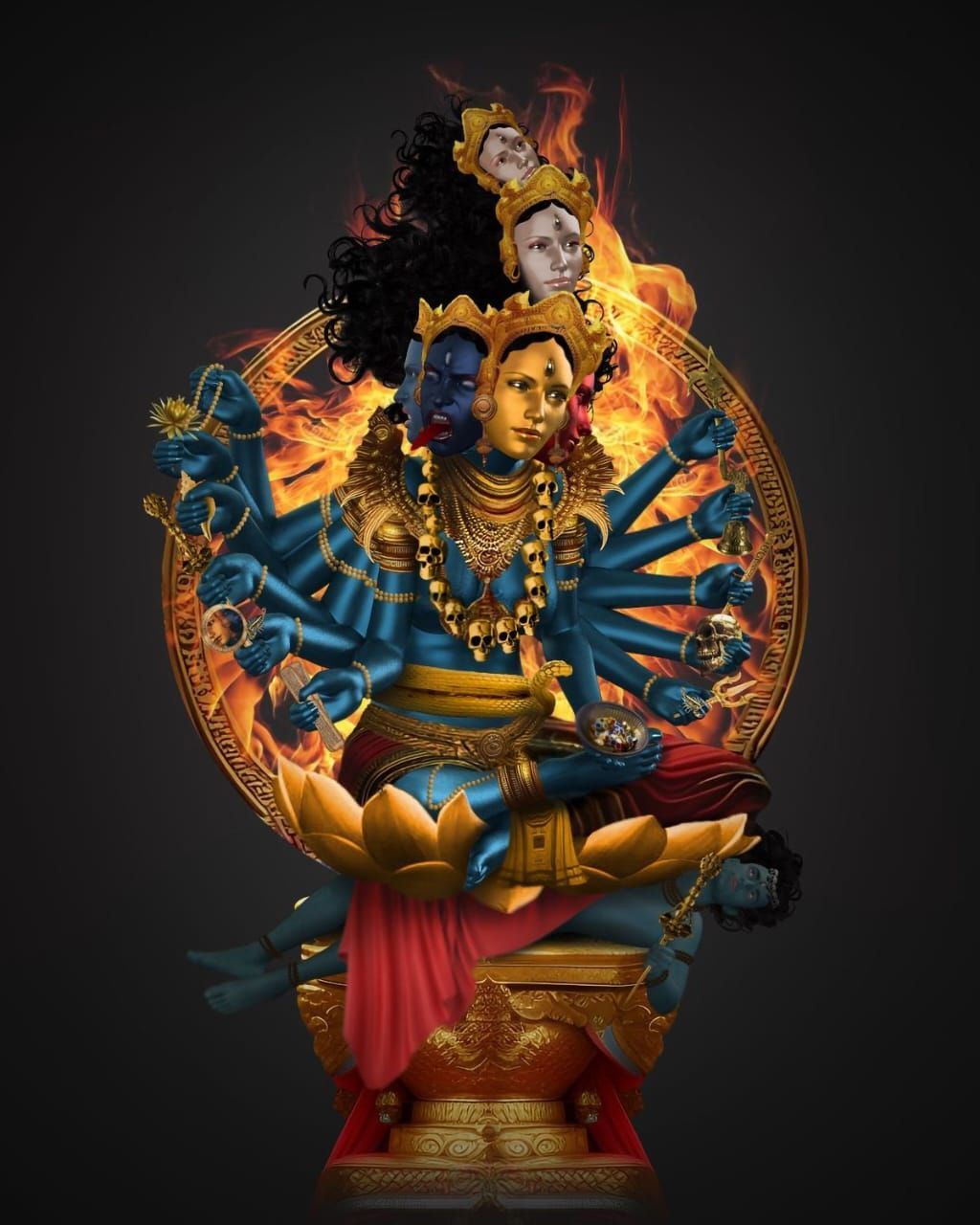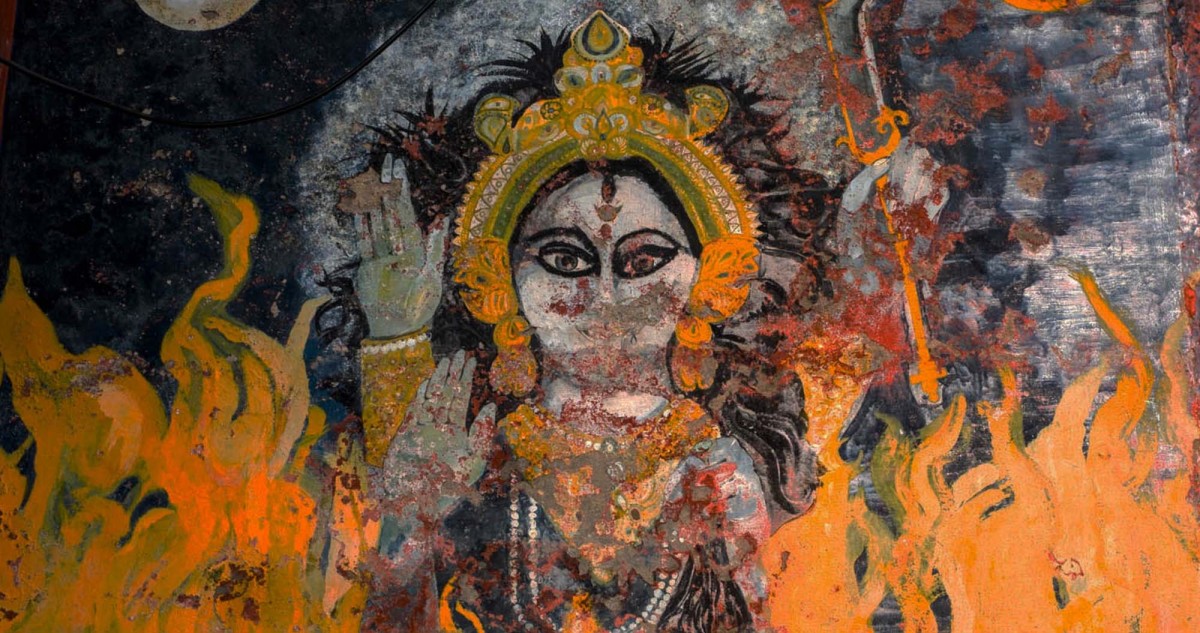Tantra, Shakti, and the Fluid Divine ~ Chris Kiran Aarya.
When people hear the word Tantra, they often imagine either an incense-soaked mystery or some kind of exotic sex ritual. But for those who practice it, Tantra is something far more profound, a path that embraces and integrates every part of our being into a single, creative whole.[i] Central to this path is Shakti, the divine feminine power that animates all of existence, the force of creation, transformation, and liberation. As the Kularṇava Tantra affirms, “Without Śakti, there is no dharma, no liberation, no truth.” At its heart, Tantra teaches us how to transform the ordinary rhythms of life from our breath, senses, and moments of change into sacred moments of spiritual awakening.
One of the earliest known Saiva Tantric manuals, is the Kubjikamata Tantra that emerged from the Kaula tradition between the 12th and 14th centuries to guide practitioners in invoking Kubjika’s shapeshifting power as a gateway to divine awakening.
The ancient verses of the Kubjikamata Tantra invite us to transcend gender as a living, breathing dance of energies rather than a fixed point on a social map. In the opening vision of the text, Kubjika manifests first in a phallic form and then, bending inward in modesty, transforms into a womb, inseminating and birthing herself in a seamless act of sacred metamorphosis This divine self-creation shatters any rigid opposition between masculine and feminine. It suggests instead that every being carries within us the seeds of both, waiting to be awakened and woven together in a fluid embrace.
This fluid understanding of gender isn’t unique to Kubjika, it also appears in other Tantric traditions as well. This idea of gender as a flowing mix of energies also appears in the Lakshmi Tantra, a sacred text that honors the goddess Lakshmi. In this tradition, Lakṣhmī is the supreme source of everything in the universe. This and other texts like the Saradatilaka Tantra tell that she and Narayana (Vishnu) are really one being called Vaikuntha‑Kamalaja, who is beyond the constraints of gender. Lakshmi holds both creative energy and peaceful awareness, showing that the divine transcends our earthly social constructs. Just like Kubjika, she reminds us that everyone holds both masculine and feminine energy inside, and that these can blend, shift, and shine in different ways. She also reminds us that we are free to express the fullness of our being, without needing to fit into fixed categories.
The Kularṇava Tantra, another key text of the Tantric Kaula tradition, echoes this expansive view of identity: “Not by caste, nor by birth, nor by family, nor even by conduct is a Kaula recognized. Only by their own inner Self-nature (svātmabhāva) are they truly known.” In this lineage, the transcendence of social constructs like gender is a sign of spiritual maturity.
 If we carry Kubjika’s story into the present, we find a radical affirmation of what I call “gender abundance.” The Goddess is not confined by a gender binary but rather the embodiment of blended energies, containing the whole spectrum of being within herself. Just as the goddess is at once source, vessel, and progeny of her own power, so too can queer people today claim multiple, shifting, even simultaneous expressions of gender without guilt, shame, or apology. The symbols of generative force and sacred receptivity become metaphors for outward expression and inward depth. And each person, whether cis, trans, intersex, nonbinary, or somewhere in between, can draw on the full spectrum of these energies and expressions within our own personhood.
If we carry Kubjika’s story into the present, we find a radical affirmation of what I call “gender abundance.” The Goddess is not confined by a gender binary but rather the embodiment of blended energies, containing the whole spectrum of being within herself. Just as the goddess is at once source, vessel, and progeny of her own power, so too can queer people today claim multiple, shifting, even simultaneous expressions of gender without guilt, shame, or apology. The symbols of generative force and sacred receptivity become metaphors for outward expression and inward depth. And each person, whether cis, trans, intersex, nonbinary, or somewhere in between, can draw on the full spectrum of these energies and expressions within our own personhood.
For many, gender has been experienced not as a source of abundance but as a burden, especially when it becomes a target for discrimination, exclusion, or violence. Tantra doesn’t deny this suffering but offers a way to transmute it, honoring even our wounds as portals of transformation.
In practical terms, Tantra encourages us to see transitional moments not as clinical or social adjustments but as sacred rites. When Kubjika shifts form, the scripture calls attention to that moment as charged with generative force. Likewise, each stage of a person’s journey can be honored as a ritual of transformation, a creative act that consecrates the threshold between who the world tells us we are – and who we know we are. The Kularṇava Tantra affirms this possibility of inner initiation without external sanction: “Even without a teacher, the one whose heart is pierced by Śakti is initiated by her directly.”
On a subtler level, Tantra’s teachings on the inner channels (nadis) and concentrated points of consciousness (bindu) offer a blueprint for somatic practices that cultivate inner fluidity. By visualizing our own energetic currents as an indivisible interplay of masculine and feminine energies, we can learn to dissolve attachments to fixed labels and ideas that we’ve been raised on. In yoga, meditation, and pranayama, we can borrow these Kaula techniques to experience freedom of consciousness, liberated from the constraints of binary thought.
The Kularṇava Tantra also reinforces the sanctity of the body in vivid terms: “The body is the abode of all the gods, the site of all sacrifices. In it are the rivers, mountains, the sun, the moon, the stars, and all the directions.” In this telling, every sensation, every shift of form, including those marked by transition or dysphoria, belongs to the sacred path of awakening.
Finally, Kubjika’s fluid energy illustrates the communal ethic of inclusion. As the goddess whose very name means “the crooked one,” she embodies not a straight path but a spiral, bending form, gender, and expectation into sacred expression. In this way, she models how diverse and gender-abundant identities can coexist within persons or in shared sacred spaces. Inclusive communities, queer collectives, and mutual care networks can draw inspiration from Tantra’s vision of fluid embodiment, creating rituals and gatherings that honor each person’s unique constellation of energies. In doing so, we transform community life into a living temple, where every shifting expression of identity is welcomed as a sacred offering.
When we weave Tantric wisdom into our contemporary lives, gender ceases to be a boundary and becomes a bridge, an opening into the boundless creativity of the self. Just as Kubjika’s body dissolves and reforms in a single gesture of cosmic play and Lakshmi flows seamlessly between creation and stillness, we too can learn to move through this world with openness, tenderness, and a reverence for the many ways the divine dances through us.
[i] This essay draws on Kaula Tantra and Śākta metaphysics through a contemporary lens, with reverence for its esoteric and initiatory roots. Texts like the Kularṇava Tantra and Kubjikamata Tantra were historically transmitted from guru to disciple and are layered in symbolic language. Here, these teachings are interpreted through an inclusive and experiential framework, consistent with Kaula’s emphasis on personal gnosis (jnana), somatic realization, and the transcendence of rigid categories such as caste, gender, and fixed identity. While terms like “gender abundance” are modern, they resonate with the Tantric celebration of multiplicity and divine play (lila).

